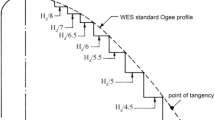Abstract
Due to their economical and structural aspects, ogee-crested spillways can be constructed and operated in a wide variety of situations. In this study, a three-dimensional physical model (1:50 scale) was planned and constructed to investigate the impact of converging training walls of the ogee spillways with a curve axis on flow characteristics such as the discharge coefficient, free surface profile, flow depth and pressure on the spillway. For this purpose, the spillway was constructed, tested and verified in both the symmetrical and asymmetrical convergence of training walls ranging from 0° to 120°. Observations from flow depth and piezometric pressure along the spillway in various convergence angles indicate that as θ increases, the flow depth and piezometric pressure increase at the bottom and the toe of the spillway model. Also, in convergence angles of 60° and 90° tested in both symmetric and asymmetric states, the angles with lower Lch/L have larger flow depth and piezometric pressure. The results of the experiments indicated that in the converging ogee spillway, by increasing the total upstream head, the discharge coefficient shows increment for each of the convergence angles (θ’s) and eventually the downstream flow changes its condition to either supercritical or critical stages. It must be considered that the discharge coefficient is independent of symmetric or asymmetric situations. On the other hand, at the submergence stage for the spillway, the difference in the discharge coefficient can be due to tailwater submergence occurring in some convergence angles. Also, the flow depth and the piezometric pressure on the bottom and the toe of the spillway increased more in the symmetrical convergence angles in comparison with the asymmetrical convergence angles. Also, by decreasing the downstream channel width to the crest length (Lch/L), the flow depth and piezometric pressure increase subsequently. Results approved that the 60° convergence is the most economic convergence angle due to its capability in passing the largest flow discharge in the maximum head. The reason for this choice is that the crest length of this angle is 33% lesser than that of 120° convergence.




















Similar content being viewed by others
References
Alavi SR, Lay EN, Makhmali ZA (2018) A CFD study of industrial double-cyclone in HDPE drying process. Emerg Sci J 2(1):31–38. https://doi.org/10.28991/esj-2018-01125
Aminoroayaie Yamini O, Kavianpour MR, Movahedi A (2015) Pressure distribution on the bed of the compound flip buckets. J Comput Multiph 7(3):181–194. https://doi.org/10.1260/1757-482X.7.3.181
Aminoroayaie Yamini O, Kavianpour MR, Hooman Mousavi S, Movahedi A, Bavandpour M (2017) Experimental investigation of pressure fluctuation on the bed of compound flip buckets. ISH J Hydraul Eng 24(1):45–52. https://doi.org/10.1080/09715010.2017.1344572
Bradley JN (1954) Studies of flow characteristics, discharge and pressures relative to submerged dams. U.S. Bureau of Reclamation, Washington
Chow VT (1959) Open channel hydraulics. McGraw-Hill Book Company, Inc, New York
Hong SH, Kim SJ, Sturm T, Stoesser T, González-Castro JA (2010) Effect of low tailwater during drought on scour conditions downstream of an ogee spillway. In: 5th international conference on fluvial hydraulics, Braunschweig, Germany, 8–10 September 2010
Jansen RB (1957) Flow characteristics of the ogee spillway. J Hydraul Div 83(6):1–11
Johnson MC, Savage BM (2006) Physical and numerical comparison of flow over ogee spillway in the presence of tailwater. J Hydraul Eng 132(12):1353–1357. https://doi.org/10.1061/(ASCE)0733-9429(2006)132:12(1353)
Khatsuria RM (2004) Hydraulics of spillways and energy dissipaters. CRC Press, Ohio. ISBN 978-3-939230-00-7
Locher FA (1971) Some characteristics of pressure fluctuations on low-ogee crest spillways relevant to flow-induced structural vibrations. No. IIHR-130
Mansoori A, Erfanian S, Moghadam FK (2017) Study of the conditions of energy dissipation in stepped spillways with Λ-shaped step using flow-3D. Civil Eng 3(10):856–867. https://doi.org/10.28991/cej-030920
Maynord ST (1985) General spillway investigation; hydraulic model investigation. Technical report (U.S. Army Engineer Waterways Experiment Station), HL-85-1, Department of the Army, Waterways Experiment Station, Corps of Engineers, Vicksburg, Miss
Mohammadzadeh-Habili J, Heidarpour M, Afzalimehr H (2013) Hydraulic characteristics of a new weir entitled of quarter-circular crested weir. J Flow Meas Instrum 33:168–178. https://doi.org/10.1016/j.flowmeasinst.2013.07.002
Morales V, Tokyay TE, Garcia M (2012) Numerical modeling of ogee crest spillway and tainter gate structure of a diversion dam on Canar River, Ecuador. In: XIX international conference on water resources CMWR, University of Illinois at Urbana-Champaign
Naghavi B, Esmaili B, Yazdi J, Vahid FK (2011) An experimental and numerical study on hydraulic characteristics and theoretical equations of circular weirs. Can J Civ Eng 38(12):1327–1334. https://doi.org/10.1139/l11-092
Niedoroda AW, Tanner W (1970) Preliminary study of transverse bars. Mar Geol 9(1):41–62. https://doi.org/10.1016/0025-3227(70)90079-4
Ramamurthy R, Tadayon AS (2009) Turbulence modeling of flows over circular spillways. J Irrig Drain Eng 135(4):493–498. https://doi.org/10.1061/(ASCE)IR.1943-4774.0000012
Ranga Raju KG, Asawa GL (1977) Viscosity and surface tension effects on weir flow. J Hydraul Div 103(10):1227–1231
Razavi AR, Ahmadi H (2017) Numerical modelling of flow in morning glory spillways using FLOW-3D. Civil Eng 3(10):956–964
Saneie M, Sheikh Kazemi J, Azhdary Moghaddam JM (2016) Scale effects on the discharge coefficient of ogee spillway with an arc in plan and converging training walls. Civil Eng Infrastruct J 49:361–374. https://doi.org/10.7508/CEIJ.2016.02.012
Shabanlou S, Khorami E (2013) Study of the hydraulic properties of the cylindrical crested weirs. J Flow Meas Instrum 33:153–159. https://doi.org/10.1016/j.flowmeasinst.2013.05.008
USACE (1987) Hydraulic design criteria. Department of the Army. U.S. Army Corps of Engineers, Mississippi
USACE (1995) Gravity dam design. EM 1110-2-1603, Department of the Army, Washington, DC
USBR (1987) Design of small dams, 3rd edn. Technical Service Center, Denver
USBR (1990) Design of spillways. Engineer manual no. 1110-2-1603, Department of the Army. U.S. Army Corps of Engineers, Washington, DC, USA
Vayghan VH, Mohammadi M, Ranjbar A (2019) A experimental study of the rooster tail jump and end sill in horseshoe spillways. Civil Eng J. https://doi.org/10.28991/cej-2019-03091295
Author information
Authors and Affiliations
Corresponding author
Rights and permissions
About this article
Cite this article
Roushangar, K., Khowr, A.F., saniei, M. et al. Investigating impact of converging training walls of the ogee spillways on hydraulic performance. Paddy Water Environ 18, 355–366 (2020). https://doi.org/10.1007/s10333-019-00787-2
Received:
Revised:
Accepted:
Published:
Issue Date:
DOI: https://doi.org/10.1007/s10333-019-00787-2




